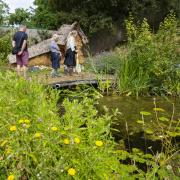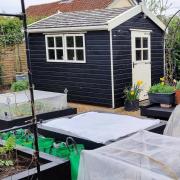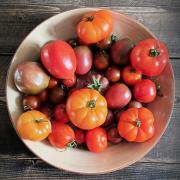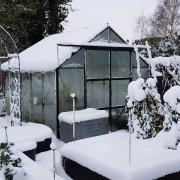There is something different in the air, listen carefully and you may hear it whispering on the breeze. Go outside, and you’ll be greeted by joyful daffodils, with their trumpet like heads all nodding with excitement. In the trees, birds rehearse their delicate tunes whilst looking down on Mother Nature, who’s busy creating warmth and colour to this season’s blank canvas. Welcome to spring!
March is a month of new beginnings, where we can finally put into action those garden plans drawn up over winter. Gardeners are pining for colour, growth and inspiration. And with Suffolk Magazine focusing on ‘Inspiring Women’, then there’s no one more inspiring in the world of horticulture than Beth Chatto.
Born in 1923, Beth Chatto was the daughter of gardening parents. Because of her lifelong interest in plants, alongside her husband Andrew Chatto, in 1960 they began work on creating The Beth Chatto Gardens. Built on wasteland that was originally part of their fruit farm, just over the border at Elmstead Market in Essex, it was here that Beth would influence UK gardens and their plants to this very day.

Due to its difficult terrain, and low annual rainfall, Andrew’s plant research led Beth to select plants that could successfully grow in different types of gardens under challenging conditions. She was a plantswoman who believed in working with nature, as important today as it was then, a pioneer of ‘the right plant in the right place’.
In the years that followed, she would open her very own nursery, win countless Gold Medals at RHS Chelsea and write several very successful garden-related books. As a key figure within the Flower Club movement, Beth gave garden talks both in the UK and abroad, demonstrated flower arranging and opened numerous gardening clubs nationwide. Throughout her career she wrote for newspapers, magazines and online content. In 2002 she was awarded an OBE for her services to horticulture, and in 2019 the RHS named her ‘Iconic Horticultural Hero’.

Although Beth Chatto sadly passed away in May 2018, at the age of 94, she would spend her final years getting out into her gardens, sharing her knowledge with staff and visitors. Today, taking the helm of these precious gardens is her eldest granddaughter, Julia Boulton. Julia's childhood is tied to this beautiful area, so continuing with Beth’s vision is truly in safe hands. ‘She believed gardening should be fun and accessible to everyone, and that is still our mission,' Julia has said.
So, as things slowly warm up, let’s embrace the new season. Try sowing flowers for summer, such as marigolds, cosmos and tithonia. Simply fill a small tray with seed compost, wet the soil thoroughly and finely scatter the seeds across the damp surface. Lightly cover over with compost, label and place somewhere warm. Check them regularly, and keep the soil moist.
Towards the end of the month, summer bulbs, including gladioli, lilies and freesias can be planted up into pots or into the ground. Plant three times the depth of the bulb to firmly anchor the roots and protect them from late frosts.

If you’ve been storing dahlias overwinter, get them out. Check tubers thoroughly and disregard any that are damaged or have succumbed to rot. Using a good multi-purpose compost, pot them up, ensuring the tubers sit just below the soil surface. Water, then place the pots in a greenhouse or cold frame. Let the tubers slowly respond to the change of season.
As the soil begins to warm, not only does it awaken dormant plants, it also encourages weeds to grow. Mulching your beds and borders will not only suppress weeds, it helps retain moisture and protects growing plants from late frosts. Compost, wood chippings or leaf mould will all do the job and smarten up any bare patches of soil.
Warming your soil with cloches and fleece for some time before growing will help to germinate early sowings of carrots, beetroot, parsnips, and cabbage. Or, sow into seed module trays and grow the emerging seedlings in cold frames and greenhouses. These can then be planted out as young plants when the weather is warmer.

New buds will be emerging on peach and nectarine trees; fleece them overnight to protect from frosts. During the day, protection should be removed as this will allow pollinators to get to the emerging blossom.
Garden wildlife will still benefit from a helping hand, so continue to replenish bird tables and feeders, ensuring there’s always a fresh water supply. Solitary bees will be leaving their winter homes and looking for somewhere new to set up for the summer. If you can, invest in a bee hotel, or make one from scratch. Whether it’s an air brick or a bunch of tied bamboo in a wooden box, they will appreciate somewhere safe to nest.
It’s a busy time for gardeners, but get it right now and in a few months you’ll be rewarded with blousy blooms and tasty veg.
If you want to visit Beth Chatto's Gardens, or learn more about Beth and her work, go to bethchatto.co.uk

Jobs for March
First early chitted potatoes can go into the ground, second earlies a few weeks later, and so on. With plenty of organic matter worked into the soil, plant tubers 15cm deep and 30cm apart. Keep fleece handy, as frost can damage emerging foliage and possibly kill plants. If you’re growing potatoes in growbags or large containers, place no more than four tubers on a 10cm base of good compost, cover with a thick layer of compost and place in a sunny, sheltered spot.
Tidy strawberry plants; cut away old leaves, weed the bed and apply a general fertiliser. If plants are over four years old, or you’re growing strawberries for the first time, consider ordering bare root varieties. Strawberries are versatile, so if space is an issue try growing them in containers, pots or hanging baskets.

The fiery stems of cornus will be fading, so cut back to just above ground level. This may seem drastic, but it will encourage a larger, more vibrant display next winter.
Once winter-flowering jasmine has finished flowering, cut back last year’s growth to several centimetres above the old wood.
Before new growth appears on hydrangeas, reduce the stems by up to a third, cutting above fresh buds.



























